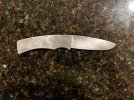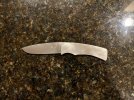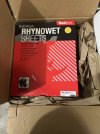- Joined
- Dec 5, 2005
- Messages
- 28,387
to be clear; I wasn't suggesting what you should or shouldn't do, but what I'd do. Sometimes when I screw something up, walking away from that project and starting a new one breathes new life into my work. Also, I'm a designer, so for me design is paramount. If a screw up gets in the way of me seeing my design through to completion, I feel I owe it to myself to see the design through to the end, and sometimes that means starting over. That's just how I roll.I think we might be back in action! Let me know if you still think I should still sidebar this one for now. Im eager to start on the next one knowing some of what I learned but this knife is like my child now, I just can’t give up on itView attachment 2080110View attachment 2080111View attachment 2080112View attachment 2080113
Maybe the most important thing to you at this point is to complete a knife, and that makes a lot of sense. One thing I'm pretty sure of, is that your second attempt will go way faster and more smoothly than your first. Whether you start after a major design-altering mistake or after you finish that altered knife may or may not make a difference in the trajectory of your work.
your altered design definitely looks workable to me.



